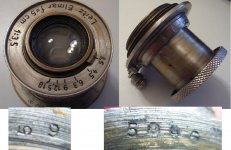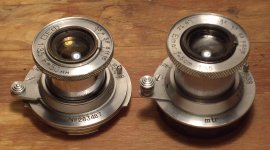The Tessar design was produced in 1902, and awarded a US patent in 1903. When the patent expired in 1920 there were many variants on the Tessar design released by other companies, such as some of Kodak's Ektars and Schneider's Xenars.
The Leica 50mm f/3.5 Elmar lens patented in 1920 and released in 1925 was a Tessar type lens but structurally different. . Zeiss Tessar and Leitz Elmar are both four element three group designs, with a rear cemented doublet, but there is major difference between the Tessar and Elmar: the position of the diaphragm. The Tessar lens has two elements in two groups in front of the diaphragm and a cement doublet behind the diaphragm; on the other hand, The Leitz Elmar lens has one group in front of the diaphragm, and one group plus one doublet behind the diaphragm.
Michael



